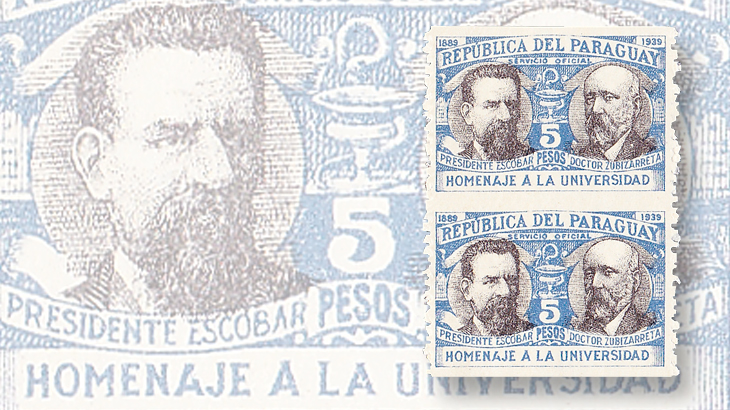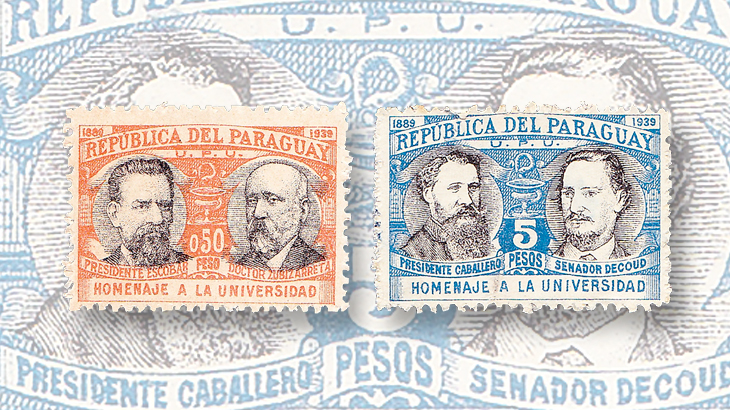World Stamps
Paraguay’s 1939-40 University stamps honor founders, offer varieties
By Thomas P. Myers
In 1939, Paraguay issued 12 stamps of similar design but for different postal purposes (Scott 351-54, C122-C123 and O99-O104) to honor the 50th anniversary of the founding of the Universidad Nacional de Asuncion.
Paraguay’s oldest university was established in 1889 during the presidency of Patricio Escobar. The large-format stamps are in two colors: black for the vignette and a different color for the frame of each denomination. The stamps were lithographed by the Talleres de Valores Oficiales in Asuncion.
A portrait of Patricio Escobar (1843-1912) is on the left of the design on the low-denomination stamps of 50 centavos (0.50 pesos), 1 peso and 2p.
Connect with Linn's Stamp News:
Among President Escobar’s other accomplishments during his term in office were the establishment of the national library and initiating obligatory primary education.
Pictured with Escobar at right in the design is Dr. Ramon Zubizarreta (1840-1902), who was the first rector of the new university.
The 5p denomination is the only stamp in the set with a different design, with a portrait of Gen. Bernardino Caballero, president of Paraguay from 1880-86, on the left. During his first two years in office, Caballero offered a general amnesty to Paraguayans who had emigrated for political reasons.
Caballero founded the university’s school of law as well as more than 70 rural schools, and encouraged immigrating Germans and Swiss-Germans to establish an agricultural colony, called San Bernardino. He was ably seconded by Jose Segundo Decoud, a government minister and major figure in organizing the new university. Decoud’s portrait appears opposite that of Caballero on the 5p stamp.
The Scott Standard Postage Stamp Catalogue lists the stamps as being perforated gauge 11½, while the specialized Catalogo de los Sellos Postales de la Republica del Paraguay, edited by Victor Kneitschel, cites both gauge 11 and 12, as well as gauge 11 by 12.
There are several noteworthy perforation varieties, including imperforate, imperforate horizontal (a pair of the 5p Official stamp, Scott O102, is shown here) and imperforate vertical. I would not be shocked to learn that these perforation varieties were contrived.
Most values also have inverted-center varieties. These, too, may be contrived, and a note in the Scott Standard catalog warns, “Examples with inverted heads were not officially issued.” The American Philatelic Expertizing Service issued a certificate of genuineness for an inverted-center example in 2005.
While the ordinary stamps are commonly found used, I have never seen any of these varieties in other than mint condition.
The number of used examples available of these issues indicates that the stamps experienced a considerable amount of service, though covers are somewhat more difficult to find. Too many stamps were soaked from their envelopes to serve the packet trade.
The airmail stamps with these designs (Scott C122-C123), issued in 1939 and perforated gauge 12, are not so easy to find, nor are airmail stamps on cover. The Official stamps, issued in 1940, also were perforated gauge 12.
MORE RELATED ARTICLES
Headlines
-
US Stamps
Oct 7, 2024, 3 PMMcMurtrie dismissed as APS education director following Sept. 21 arrest
-
US Stamps
Oct 7, 2024, 12 PMVasiliauskas named president of Mystic Stamp Co.
-
US Stamps
Oct 6, 2024, 5 PMApgar souvenir card available
-
US Stamps
Oct 6, 2024, 4 PMFirst Continental Congress and U.N. stamps receive Scott catalog numbers







